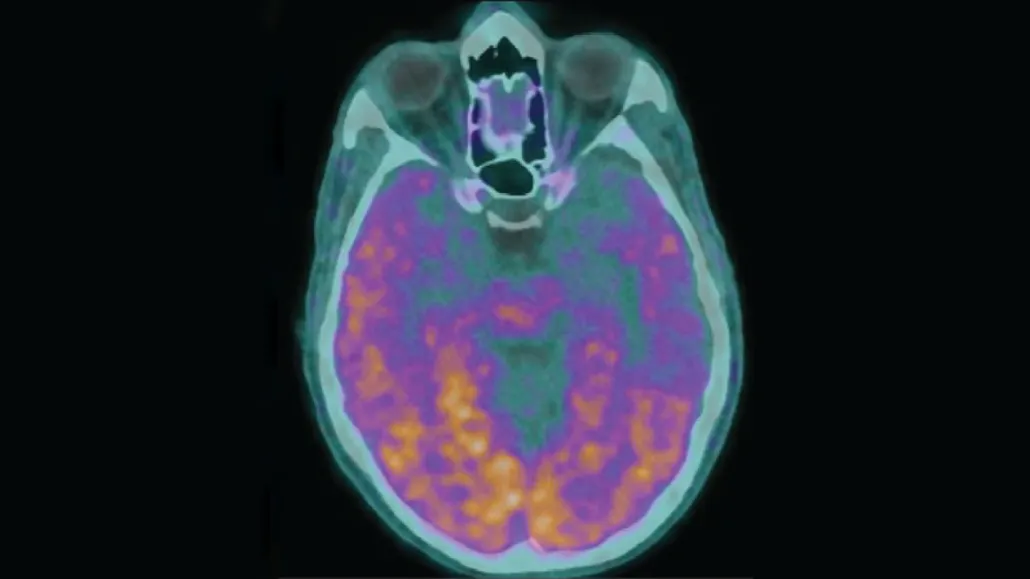Under very rare conditions, Alzheimer’s disease may be transmitted
Five patients who got tainted growth hormone injections developed early Alzheimer’s decades later

High levels of the protein amyloid-beta — a hallmark of Alzheimer’s disease — appear orange and purple in this brain scan of a man with the disease. Childhood exposure to the protein via contaminated growth hormone injections may have led the man to develop Alzheimer’s later in life.
G. Banerjee et al/Nature Medicine 2024
Under extremely rare circumstances, it appears that Alzheimer’s disease can be transmitted between people. Five people who received contaminated injections of a growth hormone as children went on to develop Alzheimer’s unusually early, researchers report January 29 in Nature Medicine.
The findings represent “the first time iatrogenic Alzheimer’s disease has been described,” neurologist John Collinge said January 25 in a news briefing, referring to a disease caused by a medical procedure.
That sounds alarming, but researchers are quick to emphasize that Alzheimer’s disease is not contagious in everyday life, including caretaking and most medical settings.
“We are not suggesting for a moment that you can catch Alzheimer’s disease,” said Collinge, of the University College London’s Institute of Prion Diseases. “This is not transmissible in the sense of a viral or bacterial infection.”
The reassurance is echoed by Carlo Condello, a neurobiologist at the University of California, San Francisco who wasn’t involved in the study. “In no way do we believe sporadic Alzheimer’s disease is a communicable disease,” he says. “Only under incredibly artificial, now out-of-date, medical practices is this appearing. It’s no longer an issue.”
Most cases of Alzheimer’s disease arise spontaneously in older people (in the United States, for instance, about 1 in 9 people aged 65 and older have the disease). That’s part of what makes these newly described cases of Alzheimer’s so unusual. Symptoms started early for these five people with Alzheimer’s — between ages 38 and 55 — and in three for whom genetic data were available, researchers ruled out the presence of mutations known to cause early-onset forms of the disease.
The people in the study had all received growth hormone injections as children or teenagers. Used to treat various growth disorders, these hormones were extracted from the pituitary glands of cadavers and combined into batches, a source that is no longer used. Some of these mixtures were later found to be contaminated with prions, infectious, misshapen proteins, that caused a disease called Creutzfeldt-Jakob disease. Globally, more than 200 people were affected. This type of growth hormone treatment stopped in 1985; doctors now use synthetic versions.
It turns out that those batches held another problem. In an earlier study, Collinge and his colleagues had found higher-than-expected levels of amyloid-beta in the brains of four people who had died with CJD. Accumulation of the sticky protein is a hallmark of Alzheimer’s and, in these cases, a worrisome signal that perhaps some of these proteins had been transferred, along with prions, from donors (SN: 9/9/15). A-beta from some of the hormone batches could spread in the brains of mice, suggesting that the protein behaves in some ways like an infectious prion, the researchers reported in 2018 (SN: 12/13/18).
Now, the researchers report on eight more people who had received contaminated growth hormone and were referred to their clinical team. None of these people had CJD, but three had already received Alzheimer’s diagnoses. Further exams showed that two more people had the disease and two had signs of cognitive trouble. One person didn’t have symptoms.
The most likely cause of these Alzheimer’s cases seems to be the unusual introduction of A-beta early in life, the researchers conclude. “Taken as a whole, the only real explanation is the shared exposure” to contaminated growth hormone, neurologist Gargi Banerjee, also at UCL, said in the Jan. 25 briefing.
That interpretation “is plausible,” says Condello. “What’s in those extracts could have done what they claim it did.”
Still, scientists can’t be certain that contaminated growth hormone caused these people’s Alzheimer’s disease. It’s possible, for instance, that the underlying childhood conditions that necessitated the growth hormone treatments, or other medical procedures such as radiation, contributed to early Alzheimer’s or cognitive problems. Several of the people suffered from seizures, which could perhaps influence cognitive problems or brain pathology. “The definitive answer may never come,” Condello says.
Beyond these rare circumstances, the results may hold clues about how Alzheimer’s disease can take hold in the brain, and whether A-beta, like a prion, incites other versions of A-beta to misfold. Untangling the details of how various forms of A-beta spread “lies ahead,” Collinge said. “A great deal more research needs to be done.”







